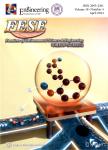Electrocatalytic biofilm reactor for effective and energyefficient azo dye degradation:the synergistic effect of MnO_(x)/Ti flow-through anode and biofilm on the cathode
作者机构:State Key Laboratory of Separation Membranes and Membrane ProcessesNational Center for International Joint Research on Membrane Science and TechnologyTiangong UniversityTianjin 300387China School of Environmental Science and EngineeringTiangong UniversityTianjin 300387China School of Materials Science and EngineeringTiangong UniversityTianjin 300387China Shanghai Advanced Research InstituteChinese Academy of SciencesShanghai 200120China University of Chinese Academy of SciencesBeijing 100049China Tianjin Water Engineering Co.Ltd.Tianjin 300222China
出 版 物:《Frontiers of Environmental Science & Engineering》 (环境科学与工程前沿(英文))
年 卷 期:2023年第17卷第4期
页 面:127-141页
核心收录:
学科分类:0710[理学-生物学] 083002[工学-环境工程] 0830[工学-环境科学与工程(可授工学、理学、农学学位)] 1003[医学-口腔医学] 0809[工学-电子科学与技术(可授工学、理学学位)] 08[工学] 0805[工学-材料科学与工程(可授工学、理学学位)] 0703[理学-化学] 0836[工学-生物工程]
基 金:This work was supported by the National Key Research and Development Program of China(No.2020YFA0211003) the National Natural Science Foundation of China(Nos.51978465,21878230,and 51878646) the Natural Science Foundation of Tianjin of China(Nos.19JCQNJC07500 and 19JCZDJC39800).
主 题:Azo dye removal Electrocatalytic biofilm reactor Anodic oxidation Electricity-stimulated biodegradation Energy consumption
摘 要:Dyeing wastewater treatment remains a challenge.Although effective,the in-series process using electrochemical oxidation as the pre-or post-treatment of biodegradation is long.This study proposes a compact dual-chamber electrocatalytic biofilm reactor(ECBR)to complete azo dye decolorization and mineralization in a single unit via anodic oxidation on a MnO_(x)/Ti flow-through anode followed by cathodic biodegradation on carbon felts.Compared with the electrocatalytic reactor with a stainlesssteel cathode(ECR-SS)and the biofilm reactor(BR),the ECBR increased the chemical oxygen demand(COD)removal efficiency by 24%and 31%(600 mg/L Acid Orange 7 as the feed,current of 6 mA),respectively.The COD removal efficiency of the ECBR was even higher than the sum of those of ECR-SS and BR.The ECBR also reduced the energy consumption(3.07 kWh/kg COD)by approximately half compared with ECR-SS.The advantages of the ECBR in azo dye removal were attributed to the synergistic effect of the MnO_(x)/Ti flow-through anode and cathodic biofilms.Catalyzed by MnIV=O generated on the MnO_(x)/Ti anode under a low applied current,azo dyes were oxidized and decolored.The intermediate products with improved biodegradability were further mineralized by the cathodic aerobic heterotrophic bacteria(non-electrochemically active)under the stimulation of the applied current.Taking advantage of the mutual interactions among the electricity,anode,and bacteria,this study provides a novel and compact process for the effective and energyefficient treatment of azo dye wastewater.



